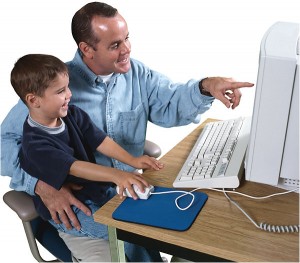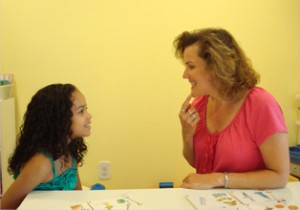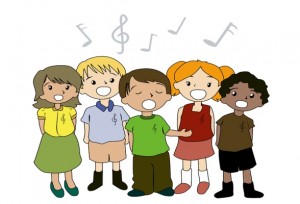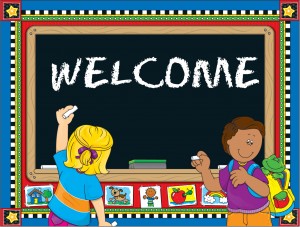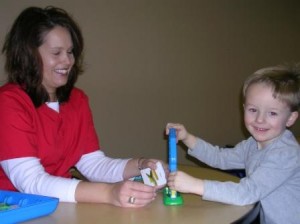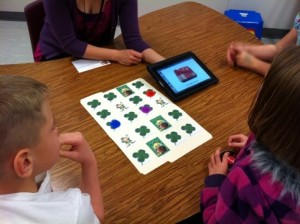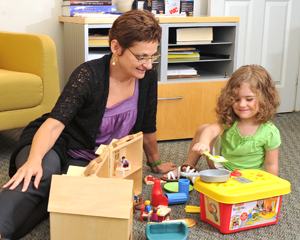Children often become more engaged in a learning activity when electronics are involved. There are lots of great apps and computer programs for speech therapy. You can also use the vast resources of the Internet to help encourage your child’s progress in speech therapy. Ask your child’s speech-language pathologist (SLP) for specific websites that she might recommend. Many websites offer games for children that are intended to build vocabulary and other important language skills. Some websites offer printable activities and flashcards that are geared toward specific sound vocalization and other speech and language skills. It’s recommended that you actively work with your child to explore Internet resources.
Computer Programs for Speech Therapy
Speech Therapy TechniquesSpeech therapy apps are great for fitting in a quick lesson on the way to soccer practice. However, you can also turn your PC into an electronic speech therapy tutor for your child. Some computer programs for speech therapy are customized for a specific speech disorder, while others offer a comprehensive range of tools. Consult your child’s speech-language pathologist (SLP) and ask for recommendations of software programs that would best suit your child’s needs.
How to Teach the “Ch” Sound
Speech Therapy TechniquesThe “Ch” Sound
The “ch” sound is produced by touching the tip of the tongue to the roof of the mouth to block the passage of air very briefly before releasing it through the mouth. Say “chicken.” Notice how the tip of your tongue touches the roof of your mouth just behind your front teeth? You might also notice that your lips pucker slightly and that your vocal cords do not vibrate when pronouncing the “ch” sound. This sound is a voiceless stop consonant. It combines the “t” and “sh” sounds.
Singing Along with Apps
Speech Therapy TechniquesSinging is a universal expression of self. There’s a good chance that your child loves to sing even if he is a bit reluctant to speak. Singing therapy, formally called melodic intonation therapy (MIT), is often used as part of a stroke recovery treatment plan. Speech therapists also use it to encourage vocalization in children with speech disorders, such as apraxia.
Collaboration vs. Pull-Out Speech Therapy
Individualized Education Program (IEP) Speech Therapy Techniques
Image source: speakandwrite.com.au
What is Pull-Out Speech Therapy?
The pull-out model of speech therapy refers to taking a child out of his usual classroom for speech therapy. This could mean either a group session or one-on-one work with the speech-language pathologist (SLP). For example, your child’s Individualized Education Program (IEP) might specify that he will receive two 30-minute speech therapy sessions per week. Using the pull-out model, he will leave his regular classroom to go meet with the speech therapist during these times.
Encouraging Collaboration in the Classroom
Speech Therapy TechniquesEvery child has his own unique needs and individual learning style. Encouraging collaboration amongst parents, teachers, and speech therapists can help a child learn more effectively in an environment that best suits his needs.
How to Teach the “R” Sound
Speech Therapy TechniquesThe “R” Sound
The “r” sound can be especially challenging to pronounce. It’s a voiced sound, produced by the vibration of the vocal cords. The reason why this particular sound is so difficult to master is that it can be correctly pronounced 8 different ways, depending on the letters with which it is combined. If you factor in the positioning of all of the variations of an “r” at the beginning, middle, or end of a word, you end up with 21 total variations.
Using Apps to Improve Articulation
Speech Therapy TechniquesYoung children often say “wabbit” for “rabbit” and “nana” for “banana.” While this is normal, bring your child to a speech-language pathologist (SLP) for an evaluation if these articulation issues continue past the expected age. An SLP can help your child produce the correct sounds. Encourage your child’s progress by working with him on speech therapy activities at home. Try old-fashioned, low-tech toys as well as high-tech apps that were designed specifically for children with articulation problems. You can also use Speech Buddies to teach proper tongue positioning.
Top Toys for Speech Therapy
Speech Therapy TechniquesWhile speech therapy is definitely going digital, you can still reap the benefits of using timeless toys like dolls and games to elicit communication and encourage proper sentence structure. Many speech-language pathologists (SLPs) customize their use of toys to the child’s individual interests. For example, an SLP might use a Grover doll for a child who loves “Sesame Street” or a Disney character for a child who loves “Aladdin.” Keeping the child engaged in learning is crucial to encourage progress.
Storytelling with Apps
Speech Therapy TechniquesStorytelling is a classic childhood activity. There are few things that draw a family together like getting the kids in their pajamas and snuggling up for a bedtime story. It’s even more rewarding when a child begins to make up his own stories. But some children with speech disorders have difficulty organizing words and sentences into a logical narration. A child with a language sequencing problem may narrate the key points of a story in an inappropriate order. He may also order words incorrectly within a sentence. Similarly, a child with an expressive language disorder struggles to choose the correct words and put them together logically.


